
Right, with Vault 101 out of the way, let’s talk a bit more in-depth about Eighton. As I mentioned previously, Eighton is based around the general area of the Super Duper Mart. I’d probably move it a little further away from DC itself in order to make it a bit safer overall, but as a location it works fine for the most part.
There’s the nearby Potomac for water, plenty of space for purifiers, several tall buildings for sniper nests and lookouts, a metric crapload of land for farming and houses, and a sturdy pre-war building for use as a town hall and council meeting area. And Greyditch just up the road as a potential allied settlement… or even part of Eighton itself.
Since the Potomac is salt water, this settlement will suffer the same basic issues as everyone else has: it needs desalination in order to be drinkable or usable for farming. And since I’d probably consider this major location to be something of a rival for Rivet City, I wouldn’t want Eighton to be reliant on them for fresh water in the way Canterbury Mega Commons is. I have a solution to this, but let’s leave that for now.
The Super Duper Mart is the central location for this settlement, as shown in the related screenshots, as it’s a large building perfect for a council to use, plus whatever other purposes they might need it for, such as storage and trade. Since we already have a heavily farming-focused location over at Canterbury, I was thinking that Eighton could instead be known for raising Brahmin in bulk in order to trade meat as one of their major commodities. There’s plenty of space around here to grow grains for the purposes of feeding the animals, and any spare can be traded or made into bread, flour, or whatever else for the settlement itself.
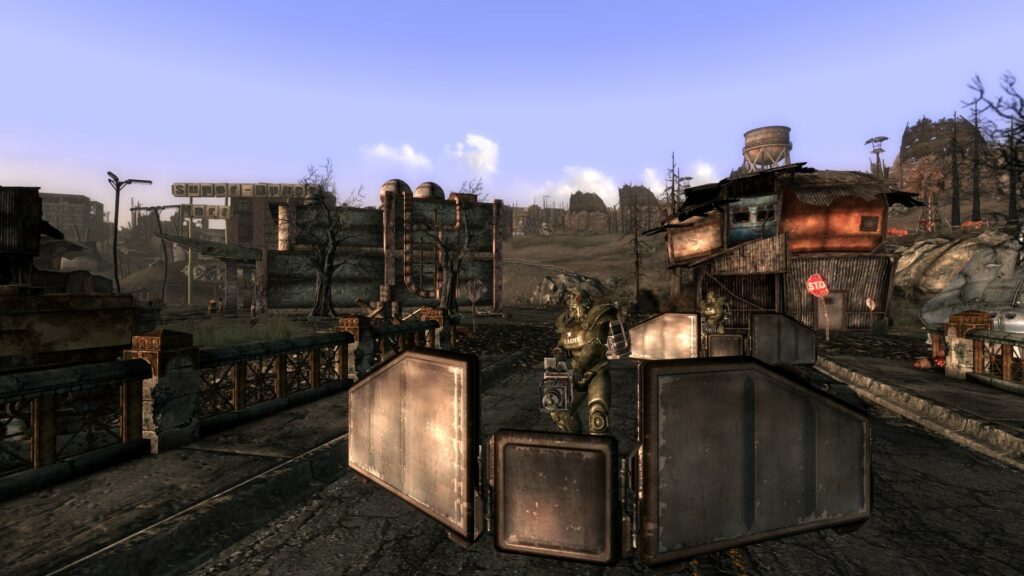
Walls surround the settlement and can potentially include a pretty sizeable area (in game terms it would have to be smaller, of course, yay, consoles), and studded between sections of wall and in other strategic locations such as facing into DC’s ruins are a number of tanks.
If you imagine something like the APCs you can come across in Fallout 4 (there’s one pretty close to where you fight Swan, but there are others scattered around the world) that’s roughly what I’m after for these vehicles, but in the screenshots I’ve just used the mining vehicles from Anchorage to illustrate things. So we have a decently-sized settlement with walls, defensive turrets mounted on old APCs, and nearby buildings providing both living accommodation and sniping / lookout spots to keep an eye on surrounding areas. Plus a community town hall / market / bazaar / council chambers or similar. And a faction with ready access to a decent stock of power armour and well-trained troops, which we’ll discuss in a moment.
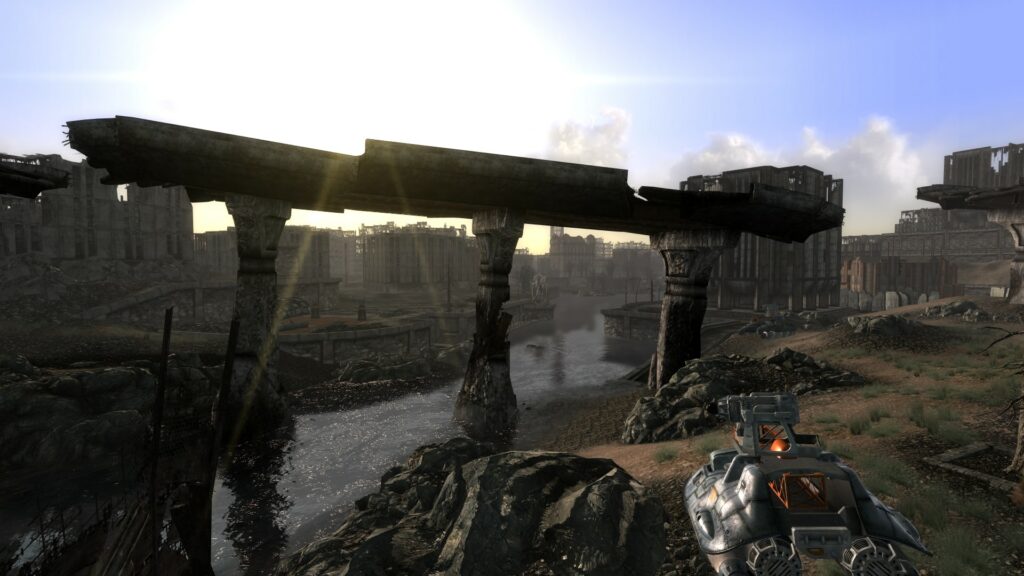
As for the faction itself, it’s split into broadly three groups; the Armour Division making up the military might of the whole faction and settlement plus environs, who utilise power armour almost exclusively; the Support Division comprising mechanics, technicians, medics, and all other support staff needed to keep the Armour Division running; and the Civilian Division, made up of the regular people of the settlement who handle farming, livestock, healthcare, schooling, and everything else a large settlement requires.
The settlement is jointly run by a council comprising members from each of the three Divisions with roughly equal power. Elections are held regularly and everyone gets a vote with the exception of criminals; children can participate—kids in a world like this would by necessity have to grow up and mature much earlier than they do in our world—but are counted for half a vote each, rounding down.
Each Division runs its own affairs for the most part—Armour covering military action, but not touching farming, for example—but for anything affecting the settlement as a whole the council will deliberate and vote based on both their own advisors and suggestions from the people.
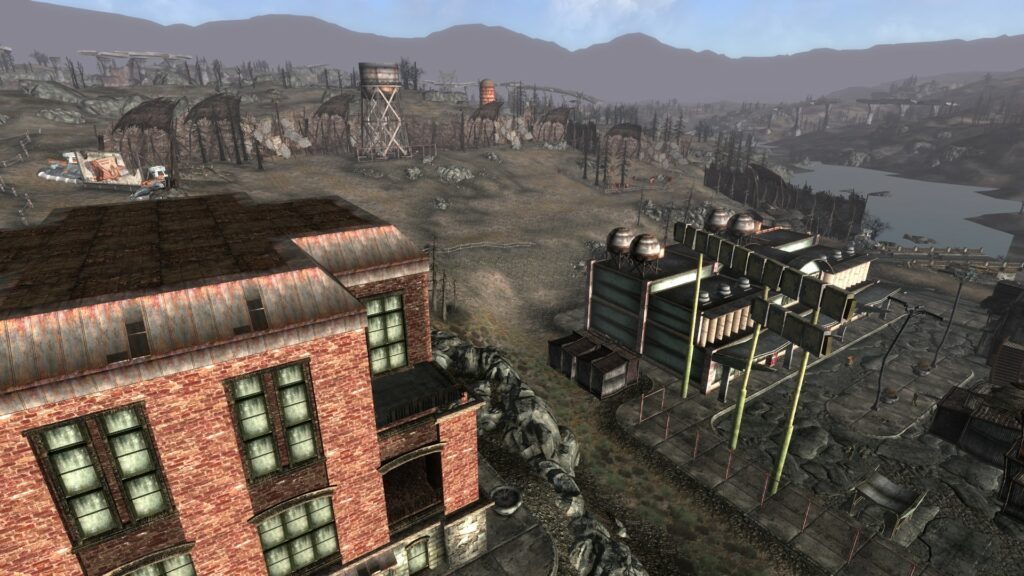
This gives us a large, successful settlement for the player to reach fairly quickly—unless they go on a random walkabout right after exiting the vault—with plenty of possibilities for inter-division problems and politics, quests arising from those, people vying for power, subsections of society who maybe aren’t happy with recent trends in the town, and all manner of other scenarios possible.
I mentioned last chapter about a hardliner faction causing problems, so let’s have a more in-depth look at the 8th EAF themselves, where they originated, and how they ended up founding a settlement near DC. The unit itself, as the name implies, was set up for extended expeditions with extensive armour (power armour + vehicles) capabilities and an impressive resume of battles fought and won.
In the years before the bombs fell, the 8th had successfully waged several campaigns against the Chinese, both on their own turf and in parts of Canada. One of the most experienced divisions in the US Army with well over a hundred suits of T-51b at their disposal (100 suits in active service + backups) plus several dozen Atomic Amphibious Assault Craft (AAACs, pronounced as ‘Ark’)—the first batch of what would have become a mainstay of the US military had the bombs not fallen first—the 8th won battle after battle.
With the Chinese invasion and subsequent occupation of Anchorage, Alaska, the US Army’s top brass saw an opportunity to push the Reds back with a determined assault centred around this strategic location. Utilising their brand new atomic-powered vehicles to good effect, the 8th mobilised but was not sent directly to Anchorage. Instead, they set up nearby, ready to move the moment they were needed.
Sending in several commando units supported by both power armour and regular troopers, the US Army pushed the Chinese out of Anchorage, sustaining heavy casualties in the process (this would tie nicely into the whole Operation Anchorage DLC, too). With the Reds on the run, retreating north along the coast towards a staging area centred around Anchorage Port, the 8th moved out.
Entering the Cook Inlet, the 8th stealthily followed the retreating Chinese remnants the roughly four kilometre distance across the inlet, using their amphibious vehicles to remain wholly undetected, to a secondary base on the other shore. The 8th remained concealed in the water until the Reds were most vulnerable; unloading their ships.
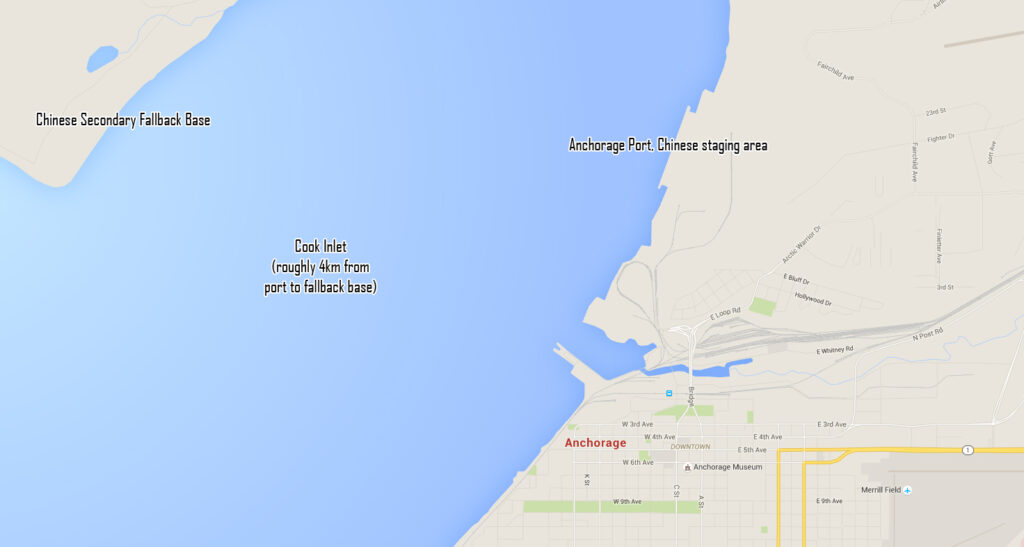
The moment the Chinese vessels docked and began unloading, the 8th attacked, driving up out of the waters the Reds had thought would keep them safe from immediate retaliation, and dropping 100 power armour units into the midst of an entirely unprepared and weakened enemy, supported by heavy plasma and laser weaponry on the AAACs.
The Chinese were routed, their secondary base destroyed, ships sunk, and every single one of the few survivors executed immediately. With this final victory in the bag, the 8th prepared to return to Anchorage, resting up on the western banks of the Inlet overnight to be at their best for the jaunt back across the water.
Unfortunately, the bombs fell that very same night, the Chinese figuring that since they’d already lost Anchorage they would poison the well. Anchorage was destroyed by several direct strikes, and the oil fields and refineries ruptured and exploded, burning constantly for weeks after the initial assault despite the extreme cold (think of the oil fields in the Gulf, similar deal). Knowing that a nuclear exchange would be the end of everything they knew and held dear, the 8th despaired.
But their commanding officer, one Major Ryan, managed to keep morale from disintegrating entirely and vowed to get them home. Packing up, they crossed the inlet and made their way south slowly, carefully, helping those they could, and avoiding unnecessary combat wherever possible, sticking to water to maintain their advantage.
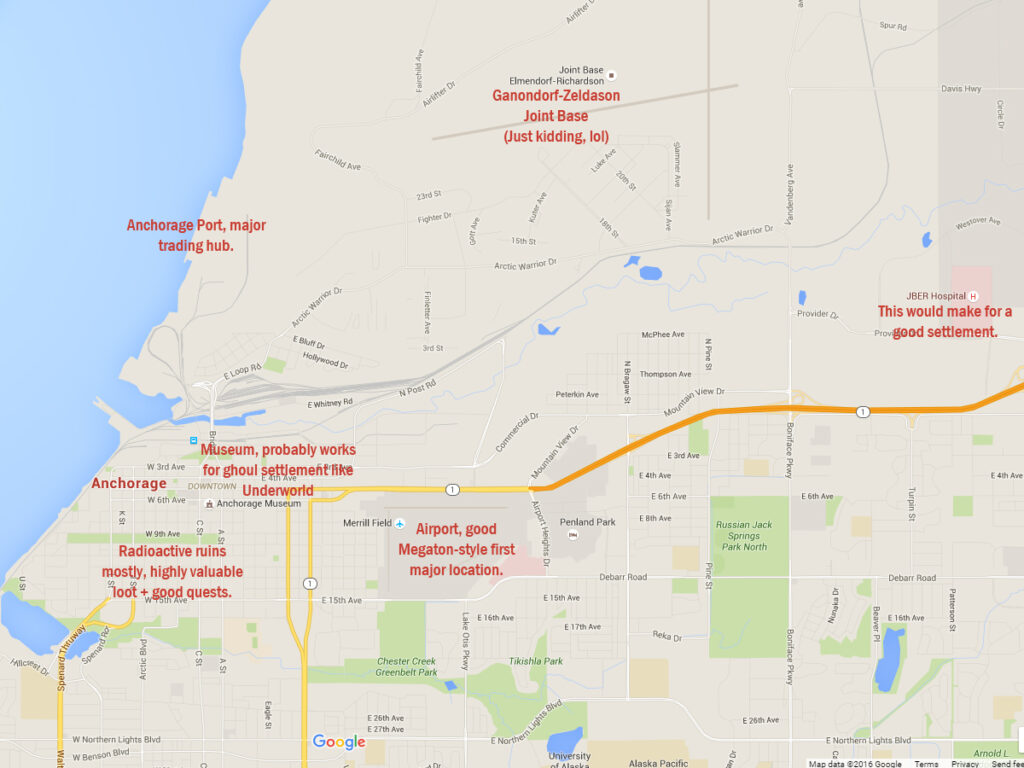
At this point I’m going to go on a brief tangent to talk about what I personally would’ve done for a hypothetical Fallout 3, if I’d been the creative director. Based on the above, I’d have set it around Anchorage itself. The 8th would’ve settled nearby, figuring trying to get across hundreds of miles of country devastated by nuclear fire would be a suicide mission, and the game would’ve been set maybe 20-50 years after the bombs.
The city of Anchorage itself would be an irradiated ruin similar to DC, but insanely dangerous due to radiation, mutated creatures and ghouls, and unstable buildings. With access to power armour (or other highly shielded outfits like radiation suits, or possibly even vehicles like the AAACs) the player would be able to enter this Hellish location to scavenge or complete quests.
Meanwhile, further out, settlements would’ve sprung up thanks to survivors banding together, the 8th would’ve created their own place (probably at the airport), and the old Anchorage Port north of the city would likely have ended up being a major trading hub. To the northeast of the city’s ruins is the Elmendorf–Richardson Joint Military Base, which I’d have repurposed and renamed a bit, using it as probably the main antagonist faction’s stronghold (this game’s Mariposa or Oil Rig equivalent).
So yeah, Fallout: Anchorage. Of course it probably never would’ve happened because Fallout has to be set in the good old US of A (at least in the minds of Bethesda), but I think a Canada setting in a frozen Arctic-style wasteland with mountains and copious greenery, trees everywhere (except those areas hit by bombs etc.), and a considerably more lush and lively appearance after two CRPGs set in desert landscapes would’ve been pretty neat. *sigh*
So anyway, back to Fallout 3 as it currently exists, which means the DC area. The 8th would’ve been originally based out of this region, and Ryan wants to get them back there to see the state of things, not to mention a lot of his troops have family there. The immediate cessation of all radio chatter indicated total destruction, so Ryan knew they were likely on their own and wouldn’t find much even if they did make it to DC, but it also gave the unit something to focus on to keep morale up.

Let’s cover the AAACs briefly, since they’re integral to the 8th’s story and feature as part of the defensive set up of Eighton. Basically, as I mentioned above, they’d be something similar in design to the APCs you see dotted around the map in Fallout 4. Except they’d need to be a good bit larger in order to fit half a dozen power armour suits into the back.
The general idea for these is that the US Army was pretty much desperate for a convenient means of dropping power armour into hot zones and therefore needed a new type of vehicle to accomplish this, something powerful that could also be used to lay down suppressing / covering fire.
They ultimately went with an amphibian vehicle with a heavy turret (plasma or laser) that could rapidly deploy power armour units to hot zones, especially when they were dealing with a region where water was a big issue. Each vehicle also has a microfusion reactor, a technology which ultimately could have prevented the war… if it hadn’t been developed too late.
What this does is it gives me a convenient vehicle to have dotted around the perimeter of the Eighton settlement itself for protection purposes, but the microfusion reactors inside the vehicles are actually the most important aspect.
Water desalination actually takes a substantial amount of power. Microfusion reactors provide a substantial amount of power. Therefore, if we utilise one of the AAACs to power our desalination plant… all is well, and Eighton isn’t reliant on Rivet City. This is essentially Eighton’s version of what Tenpenny’s faction did when they removed the reactor from a locomotive to power their own region.
Back to the Eighth themselves…
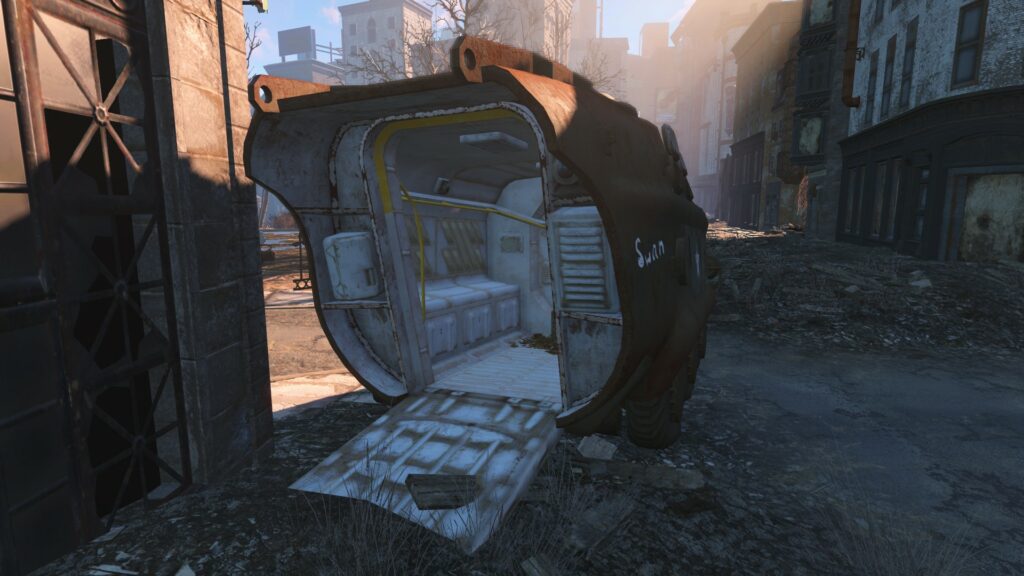
Sixteen of the AAACs would be used for the full compliment of 100 power armour suits, while the other four were used for transporting the 8th’s tents, equipment, and other necessities. No units were lost during the destruction of the Chinese secondary base, so the 8th started their trek back to DC with the full twenty vehicles. Atomic power meant they would run effectively forever, so with heavy hearts they moved out, making their way slowly down the coast.
Over the course of many months they crawled steadily south towards the US border, eventually making their way across to the east in hopes of finally reaching DC. Keeping the vehicles and power armour in working order turned out to actually be the easiest part of their journey.
Lack of medical supplies for a trip of this length, along with injuries and a lack of good quality food accounted for more deaths than virtually anything they encountered en-route. Add to this the addition of refugees and others the 8th couldn’t bring themselves to turn their backs on, and things soon became strained.
Eventually, they arrived and found a DC quite unlike the one they had left behind when they were originally stationed in Canada. They grieved over lost loved-ones, some lost their minds entirely and wandered into the wastes, never to be seen again, and over time the survivors managed to come to terms with their situation.
Finding a relatively untouched and undamaged building (the Super Duper Mart), they used the remaining AAACs to haul wreckage from nearby buildings, using the metal and concrete to create a new settlement around this building and placing the vehicles strategically at points around the entire perimeter, turrets armed and ready to spew plasma or searing laser death at a moment’s notice. And various hangers-on became the first of Eighton’s civilian settlers.
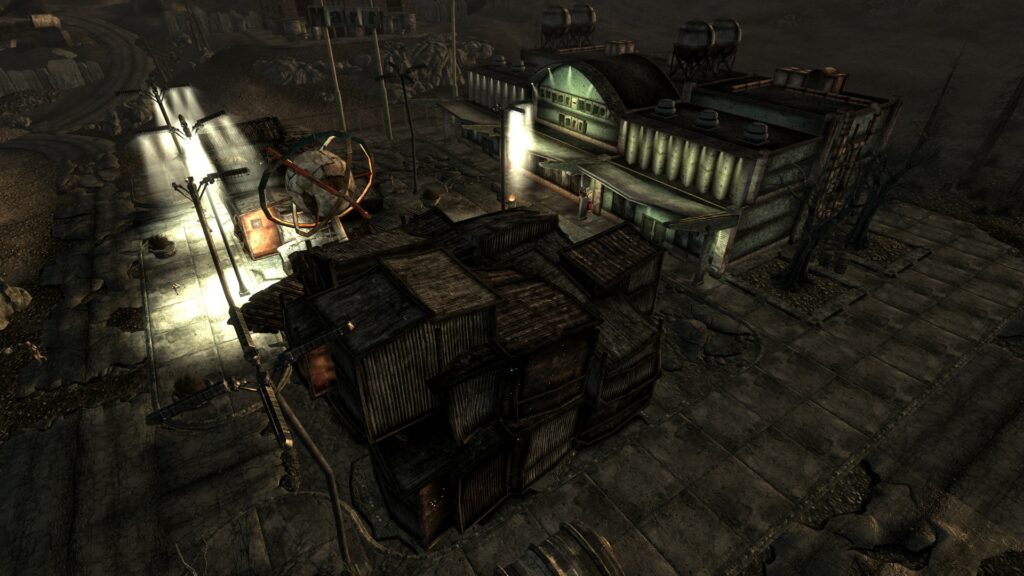
Over time the settlement grew larger as people from the local region heard rumours of a powerful force fighting mutants and degenerates, and Eighton was officially founded, turning a hastily constructed military stronghold into a thriving community. Over the years things changed and improved, the council was created, and Eighton became known far and wide as the new centre of civilisation in a hostile world.
Other settlements grew as well, such as Canterbury Mega Commons and Big Town, and eventually trading caravans began moving steadily between them, providing labour and goods from one location to another, creating a free market of sorts. Some settlements declined to take part but stayed on peaceful terms (such as Old Olney; yes, I’ll be talking about this place soon), and overall the world was made just a little nicer and a little safer by the efforts of the 8th Expeditionary Assault Force.
And we’re done! The player can leave the Vault, travel to Eighton, and find a thriving community to trade with, take quests from, and influence in various ways. The 8th themselves recruit heavily from both their own people and the fittest and most intelligent members of the wastes they can find, keeping up their numbers and ensuring the arcane knowledge behind their power armour and vehicles is never lost.
They have some problems, notably the aforementioned hardliners who think the community has become too soft and are therefore trying to sway things back to a more militaristic standpoint, but the moderates of the faction are mostly keeping things balanced for now. The player will be able to influence this via quests and the main questline itself, potentially ousting one or other of the two groups and changing the politics of the region.
Lastly, a quick note on ideas and world building like this. When brainstorming and coming up with ideas, you’ll throw a lot of things out, some things will be changed entirely, and you might end up with a world quite different to the one you originally started crafting. I mentioned this in a previous chapter; it’s par for the course when you start building a new fictional world.
With that in mind, I’ll say this: all of these ideas are effectively just starting points for further development and discussion. The 8th could’ve been a riot control force stationed in DC itself, they could’ve been on ‘pacification’ duty, they could’ve been anything, rather than stationed WAY out in Anchorage.
I dislike bending reality to make something work through contrivance and convenience (like, for example, ripping the Brotherhood from California and dumping them down in Washington, and yes, I realise Bethesda borrowed the silly Fallout: Tactics lore to justify that), but I’m also working within the framework of the game as it stands, which means the DC region. Hence why I mentioned above that I might’ve simply set the game in Anchorage itself to avoid such a contrivance.
The Anchorage connection is simply nice for something to explore further in the DLC, potentially showing some background of the unit itself during the war that you’d experience first-hand via the simulation, meaning it would be directly tied to the events of the present, rather than just being a random door-opening quest for the Outcasts as it is now.
And if you’re thinking that a major trek from Alaska all the way back to DC seems ridiculous, I’ll just leave you with this link to the Lewis and Clarke Expedition. It’s not as far-fetched as you might imagine, and they didn’t have rugged, atomic-powered, armoured personnel carriers and power armour either.
Anyway, next up I’ll dig a bit into the Talon Company mercs, plus the Regulators and Reilly’s Rangers.
If you enjoy my work, consider buying me a coffee, or jump onto my newsletter to receive updates, free chapters, stories, and other goodies.


